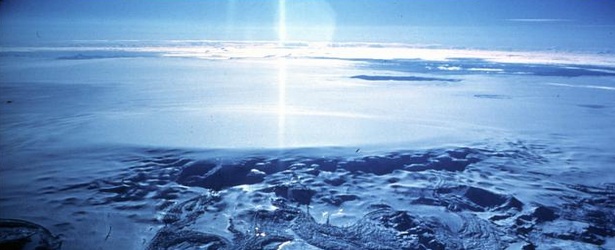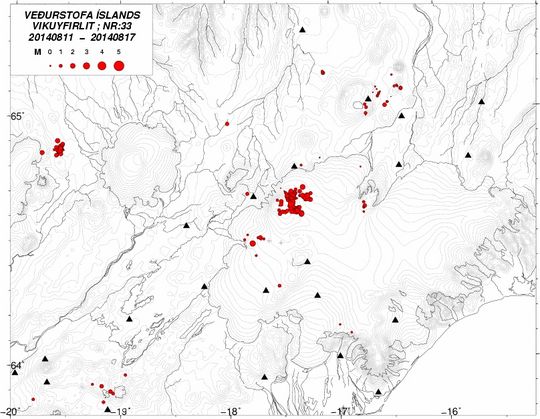Intense earthquake swarm started at Bardarbunga volcano, Iceland

Icelandic Met Office (IMO) is reporting a sharp increase in seismic activity close to subglacial stratovolcano Bárðarbunga in NW Vatnajökull ice cap. A seismic swarm has been ongoing since 03:00 UTC on August 16, 2014, and near continuous earthquakes have been occurring since then.
This is the most intense earthquake swarm in this area for years, according to IMO. The last confirmed eruption of this volcano took place on June 18, 1910 (VEI 2), while the largest known eruption (VEI 6) took place in February 1477. In historic times there have been large eruptions of this volcano every 250 – 600 years.
The depths of earthquakes in the present swarm are in the upper crust and their magnitudes are mainly around 1.5; a few earthquakes are of magnitude greater than ML3.
Long-term seismic and GPS data indicate that there is increased unrest in the northwestern region of Vatnajökull glacier, where Bárðarbunga is located:
Over the last seven years seismic activity has been gradually increasing in Bárðarbunga and the fissure swarm north of the volcano. This activity dropped down at the Grímsvötn eruption in May 2011, but soon after, the activity started to gradually increase again and has now reached similar level of activity to that just before the Grímsvötn eruption. Earlier this year, in the middle of May 2014, there was a small swarm of over 200 events and now the present swarm has already generated at least 300 earthquakes.

Earthquake swarm by Bardarbunga volcano August 16, 2014. © IMO
Since early June 2014, displacements at GPS stations around Vatnajökull (Hamarinn, Grímsfjall, Vonarskarð and Dyngjuháls) show an increased upward movement and away from Bárðarbunga.
Together, these two systems indicate magma movements in Bárðarbunga. Due to increased seismicity IMO has decided to turn volcano Bárðarbunga status to yellow on the aviation color code map. In case of a sub-aerial eruption, an ash plume of potential concerns for aviation will be generated.
At 23:00 on August 16, there was no unequivocal indication that magma has reached the surface.
The Global Volcanism Program has no Weekly Reports available for Bárdarbunga.
The Bárðarbunga caldera is about 70 square kilometers, up to 10 kilometers (6 miles) wide and about 700 meters (2 300 ft) deep.
Geologic summary
The large central volcano of Bárdarbunga lies beneath the NW part of the Vatnajökull icecap, NW of Grímsvötn volcano, and contains a subglacial 700-m-deep caldera. Related fissure systems include the Veidivötn and Trollagigar fissures, which extend about 100 km SW to near Torfajökull volcano and 50 km NE to near Askja volcano, respectively. Voluminous fissure eruptions, including one at Thjorsarhraun, which produced the largest known Holocene lava flow on Earth with a volume of more than 21 cu km, have occurred throughout the Holocene into historical time from the Veidivötn fissure system.
The last major eruption of Veidivötn, in 1477, also produced a large tephra deposit. The subglacial Loki-Fögrufjöll volcanic system located SW of Bárdarbunga volcano is also part of the Bárdarbunga volcanic system and contains two subglacial ridges extending from the largely subglacial Hamarinn central volcano; the Loki ridge trends to the NE and the Fögrufjöll ridge to the SW. Jökulhlaups (glacier-outburst floods) from eruptions at Bárdarbunga potentially affect drainages in all directions. (GVP)
Featured image credit: GVP

Earthquake and volcano eruption in Iceland in August 2014 which could cause some impact on aviation industry including travels seem to be a prelude to predictions in my article – " Stressful times ahead for world economy in 2015 and 2016" – published on 2 June 2014 online at Astrologyweekly. Briefly speaking, my predictions, among other things , are that there is likelihood of earthquakes , eruptions in regions or countries hinted which could have some impact on aviation industry during Nov 2014 to mid -2016. Appropriate precautions are always useful.
Lets get ready to crumble
https://www.youtube.com/user/brahmin21